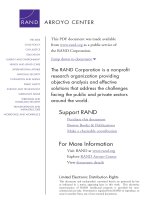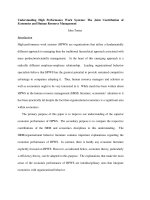HUman resource managemenr 2e s keiman chapter11
Bạn đang xem bản rút gọn của tài liệu. Xem và tải ngay bản đầy đủ của tài liệu tại đây (288.11 KB, 36 trang )
Chapter 11
Complying with Workplace Justice Laws
© 2010 Cengage Learning. Atomic Dog is a trademark used herein under license. All rights reserved.
Chapter Outline
•
11-1 Gaining Competitive Advantage
•
11-2 HRM Issues and Practices
•
11-3 The Manager’s Guide
© 2010 Cengage Learning. Atomic Dog is a trademark used herein under license. All rights reserved.
11-1a Opening Case: Gaining Competitive
Advantage at the Marriott
•
Problem: Marriott’s open-door policy fails to resolve
employee complaints.
•
Solution: Implement a peer review process.
•
How the peer review process enhanced competitive
advantage
Number of EEO charges dropped by 50 percent in the
first year and by 83 percent in the second.
Litigation costs reduced, yielding enormous savings.
Employee morale improved dramatically as they had a
complaint system they trusted.
© 2010 Cengage Learning. Atomic Dog is a trademark used herein under license. All rights reserved.
11-1b Linking Workplace Justice
to Competitive Advantage
•
Workplace justice laws deal with the fairness of
organizational practices that dictate the day-to-day
treatment of employees.
•
Competitive advantage can come from:
Reducing litigation costs.
Favorably affecting employee attitudes and behaviors.
Promoting a favorable company image.
© 2010 Cengage Learning. Atomic Dog is a trademark used herein under license. All rights reserved.
11-2a Workplace Justice and Employment
Discrimination
•
Discrimination in the day-to-day treatment of
employees:
Sexual harassment
Pregnancy discrimination
Family and medical leave
Fetal protection policies
Discharge and discrimination
Layoffs and discrimination
Early retirement and discrimination
© 2010 Cengage Learning. Atomic Dog is a trademark used herein under license. All rights reserved.
© 2010 Cengage Learning. Atomic Dog is a trademark used herein under license. All rights reserved.
11-2a Workplace Justice and Employment
Discrimination (cont.)
•
Problems caused by sexual harassment
Increase in employee turnover
Increase in absenteeism
Decrease in employee morale
Lack of effective teamwork
Poor productivity
Employee stress and/or psychological problems
Costly compensation damages
© 2010 Cengage Learning. Atomic Dog is a trademark used herein under license. All rights reserved.
11-2a Workplace Justice and Employment
Discrimination (cont.)
•
Forms of sexual harassment
Quid pro quo
-
Hostile environment
-
Refers to a situation in which an employee or applicant
must provide sexual favors in order to be hired,
promoted, granted a pay raise, or allowed to keep a job.
Employees are subjected to unwelcome, intimidating
working conditions.
Reverse sexual harassment
-
Occurs when person is denied an employment
opportunity that was given to someone who complied
with requests for sexual favors.
© 2010 Cengage Learning. Atomic Dog is a trademark used herein under license. All rights reserved.
11-2a Workplace Justice and Employment
Discrimination (cont.)
•
Steps an employer should take for dealing with
sexual harassment:
Establish a written sexual harassment policy.
Provide supervisory training that focuses on the legal
definition of sexual harassment.
Establish investigative guidelines that maintain
employee confidentiality.
Establish a committee composed of both men and
women to investigate sexual harassment claims.
Establish a means for detecting unreported cases of
sexual harassment within the company.
© 2010 Cengage Learning. Atomic Dog is a trademark used herein under license. All rights reserved.
© 2010 Cengage Learning. Atomic Dog is a trademark used herein under license. All rights reserved.
11-2a Workplace Justice and Employment
Discrimination (cont.)
•
Pregnancy Discrimination Act
Pregnancy discrimination is a form of sexual
discrimination and therefore illegal.
Firms may not discriminate against employees on the
basis of pregnancy, childbirth, or related medical
conditions.
Employees who are unable to perform their jobs
adequately because of a pregnancy-related condition
must be treated similar to employees who are
temporarily disabled for other reasons.
© 2010 Cengage Learning. Atomic Dog is a trademark used herein under license. All rights reserved.
© 2010 Cengage Learning. Atomic Dog is a trademark used herein under license. All rights reserved.
11-2a Workplace Justice and Employment
Discrimination (cont.)
•
Fetal Protection Policies (FPPs)
Exclude women of childbearing age from jobs that
could cause potential reproductive hazards.
-
Examples—Jobs involving toxins and those that can
cause sterility, infertility, sperm abnormality, stillbirth,
miscarriage, birth defects, or damage to sexual organs.
Women are exempt only if they can show proof of
surgical sterilization.
© 2010 Cengage Learning. Atomic Dog is a trademark used herein under license. All rights reserved.
11-2a Workplace Justice and Employment
Discrimination (cont.)
•
Guidelines for dealing with fetal protection policies:
Support federal research on reproductive risks.
Estimate the extent of health risk for the firm’s
employees.
Fully inform employees about health risks.
Consider technological controls.
Reduce employee exposure to toxic substances.
Implement a fetal protection policy.
© 2010 Cengage Learning. Atomic Dog is a trademark used herein under license. All rights reserved.
11-2a Workplace Justice and Employment
Discrimination (cont.)
•
Discharge and discrimination
Employee misconduct occurs when an employee
commits an infraction of workplace rules.
Firms must implement discipline and discharge
policies for ensuring fair enforcement of those rules.
-
-
Just cause : The cause of action should be a fair one.
Due process: Employees should be informed of the
charges against them and be given an opportunity to
defend themselves.
Progressive discipline system: Discipline is enforced in
increasingly severe steps; starting with an oral warning
and ultimately termination.
© 2010 Cengage Learning. Atomic Dog is a trademark used herein under license. All rights reserved.
11-2a Workplace Justice and Employment
Discrimination (cont.)
•
Discharge and discrimination—Poor performance
-
Discharge is usually considered a last resort.
Employer must be able to prove that the discharge was
performance-based.
If required, employer must provide other evidences such
as adequate documentation of poor performance or
efforts taken by manager to improve substandard
performance by providing counseling,
© 2010 Cengage Learning. Atomic Dog is a trademark used herein under license. All rights reserved.
11-2a Workplace Justice and Employment
Discrimination (cont.)
•
Layoffs and discrimination
Employers can defend themselves by:
-
-
Demonstrating that the layoff was not simply a guise for
discrimination, but was based on genuine business
concerns.
Providing evidences of lagging sales, growing inventory,
or a depressed economy.
Providing evidences of consideration to options such as
transferring employees into vacant positions, placing
them in newly created part-time positions, or allowing
them to work a shorter workweek.
Claims of discrimination can also be refuted by
statistical evidence.
© 2010 Cengage Learning. Atomic Dog is a trademark used herein under license. All rights reserved.
© 2010 Cengage Learning. Atomic Dog is a trademark used herein under license. All rights reserved.
11-2b Employee Privacy Rights
•
Intrusions on an employee’s privacy can cause:
Resentment
A climate of fear and suspicion
Low morale
Increased turnover
Increased absenteeism
Reduced productivity
Expensive lawsuits
© 2010 Cengage Learning. Atomic Dog is a trademark used herein under license. All rights reserved.
11-2b Employee Privacy Rights (cont.)
•
Four privacy-related practices that are legally
regulated:
Information collection and use
Search
Surveillance and monitoring
Enactment of workplace rules
© 2010 Cengage Learning. Atomic Dog is a trademark used herein under license. All rights reserved.
11-2b Employee Privacy Rights (cont.)
•
Information collection and use
Employers have a right to collect and maintain
information about employees.
Employees may justifiably lodge an invasion of privacy
claim if the information collected by an employer is
irrelevant to the employer’s business needs.
According to the Privacy Act of 1974, public sector
employees have the right to:
-
Determine what information is being kept on them by
their employers.
- Review that information and correct erroneous
information.
- Prevent the information from being used for a purpose
other than that for which it was collected.
© 2010 Cengage Learning. Atomic Dog is a trademark used herein under license. All rights reserved.
11-2b Employee Privacy Rights (cont.)
Freedom of Information Act of 1966
-
Makes most government records available to the public.
Individuals may view these records with proper
authorization.
Makes exceptions for personnel files and medical
information.
Private sector employers must ensure that information is
given in good faith, no malice is intended, and the
receiving party has a legitimate reason for wanting the
information.
© 2010 Cengage Learning. Atomic Dog is a trademark used herein under license. All rights reserved.
11-2b Employee Privacy Rights (cont.)
•
Searches
Organizations conduct searches to prevent theft,
detect the presence of alcohol or drugs, or recover
stolen property.
Employer’s behavior in this area is regulated by the
common law of intrusion upon seclusion.
-
A person’s privacy rights are violated when the intrusion
upon his or her private concerns would be considered
highly offensive to a reasonable person.
© 2010 Cengage Learning. Atomic Dog is a trademark used herein under license. All rights reserved.
11-2b Employee Privacy Rights (cont.)
An employer’s search must meet three criteria:
-
Reasonable basis for conducting the search.
Written guidelines should inform employees of its search
policy.
All precautions to ensure the search is not conducted
offensively or abusively.
© 2010 Cengage Learning. Atomic Dog is a trademark used herein under license. All rights reserved.
11-2b Employee Privacy Rights (cont.)
•
Surveillance and monitoring
Methods include:
-
Monitoring phone calls, e-mail, and Internet use.
Watching employees through closed-circuit televisions.
Using private investigators to watch employees outside
the workplace.
Using global positioning systems to track the
employees’ locations when using company vehicles and
company-provided cell phones.
Such practices degrade employees, may lead to
stress, and hinder employee morale.
© 2010 Cengage Learning. Atomic Dog is a trademark used herein under license. All rights reserved.




![audio engineering 101 [electronic resource] a beginner's guide to music production](https://media.store123doc.com/images/document/14/y/ii/medium_iij1401381447.jpg)
![broken markets [electronic resource] a user's guide to the post-finance economy](https://media.store123doc.com/images/document/14/y/kz/medium_kzd1401381668.jpg)
![ios sdk programming [electronic resource] a beginner's guide](https://media.store123doc.com/images/document/14/y/ph/medium_phw1401472929.jpg)


